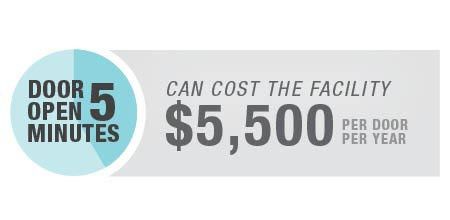The Power of Access Automation
Whether designing multi-unit residential, mixed-use or commercial spaces, architects must be attentive to opportunities to specify integrated access solutions.While not only protecting businesses’ key stakeholders from possible security threats, risk of personal injury and damage to property, an automated system offers long-term financial and energy savings that can significantly improve the overall efficiency of buildings. How, then, are these integrated access solutions impacting facility design, and how is technology creating safe, more connected spaces?

Maintaining Authorized Ingress & Preventing Theft
Controlling access around the perimeter of a facility is truly the first line of defense to consider. For example, a fully integrated gate with remote traffic spikes system provides a barrier that strictly enforces one-way, credentialed traffic, eliminating unauthorized entries or exits.  Automated gates have proven to deter the potential of on-site theft and vandalism to vehicles and other valuables. Considering access solutions, both inside and outside a facility, during the architectural design phase results in a seamless, system that provides unparalleled security against theft.
Automated gates have proven to deter the potential of on-site theft and vandalism to vehicles and other valuables. Considering access solutions, both inside and outside a facility, during the architectural design phase results in a seamless, system that provides unparalleled security against theft.
Consider first how automated access systems, such as mechanized gates and motorized door operators can reduce a business’ exposure to crime – a prevalent issue in the United States’ commercial sector where cargo theft remains an estimated $15 to $30 billion-dollar problem each year. Entrances and exits equipped with advanced smart controls and remote diagnostics give end-users the ability to control access both into and throughout the facility, as well as access to restricted areas and inventories. When doors are fitted with RFID readers, for example, access throughout a facility can be regulated, monitored and tracked.
Additionally, warehouses and distribution centers that couple overhead doors with automated operators with WiFi technology can safely and effectively monitor access to inventory, and protect storage spaces from intruders. These smart sensors and warning alerts can notify facility managers of unauthorized access to allow them respond appropriately.
Limiting Injury & Ensuring Equipment Longevity
Controlling access around a property is one of the many ways to ensure a safe community and working environment, but automated access systems can take safety a step further by eliminating the stress and strain related to manually opening and closing doors or gates.

The National Safety Council estimates that every seven seconds, a worker is injured on the job, with more than 100 million production days lost each year due to work-related injuries such as heavy lifting and overexertion. Automating access points around shipping and receiving areas or dock doors can help businesses reduce the risk of certain injury claims and increased insurance premiums.
Automating access points also reduces the wear and tear doors can endure when operated manually. Safety innovations such as positioning sensors, photo-eyes and pressure-sensitive edges ensure proper operations, extend door life, and minimize a company’s risk of potential liability in operator accidents. Automation helps to maintain the longevity of the door, reducing maintenance costs and providing customizable flexibility to keep a system operating at peak performance even in the harshest working conditions.
Capitalizing on Energy Savings
By installing automated door operators with an internet-connected solution, building planners can optimize energy efficiency and give businesses an immediate return on their investment—especially those with multiple entries and exits. Manual doors require someone to close them, and when there isn’t an employee around to do the job, many doors are left open throughout the day. An open door can impact the overall performance of a building.
This automated control is essential to maintaining proper indoor temperatures, which can have a significant impact on a facility’s maintenance expenses. In fact, research shows that a cold storage facility with fourteen dock doors left open for just five minutes after each truck pulls away can cost the facility almost $5,500 per door, per year.
Given these money saving considerations, in addition to the recognized shortcomings of outdated, manual access systems, it’s easy to see why automation has become a growing trend in the design phase of nearly every modern commercial endeavor. Incorporating a unified, proactive access system with internet-connected functionality can provide innumerable capabilities to a property’s key stakeholders, including the steams of people venturing into and out of a space each day.

